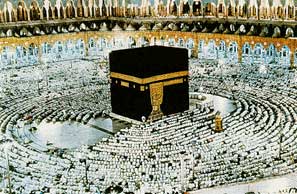Many obstacles and limitations come against me during Project Conversion. One of those is visiting the holy places of each religion. Sometimes I have to remind myself that, while I am always welcomed to explore the religion, there are some portions which are off-limits. These are the holy, members-only sections of religion.
Enter the fifth and final pillar of Islam: The Hajj.
The hajj, or pilgrimage, is an ancient Arabian practice. Dating before the time of Muhammad (pbuh), the tradition involved pilgrims coming from all over the Arabian Peninsula and beyond to place their idols inside the Kaaba, the large cube temple said to have been constructed by Abraham and his son, Ishmael. The Kaaba is surrounded by the Masjid-ul Haram (the Grand Mosque in Mecca). Once Islam became the dominate religion of Mecca, the Kaaba was “restored” as the first temple to Allah where Muslims make pilgrimage to today.
Muhammad enjoined Muslims to make the hajj at least once in their lifetimes, provided they are physically and financially able. The hajj is made during a specific time of year, the twelfth month of the Islamic lunar calendar, and so millions of Muslims from all over the world converge on one of the largest single gatherings on the planet. Each Muslim arrives at the Kaaba (the central structure above covered in a black veil) in ihram, simple white clothing or robes, which erase all distinctions of class, status, or race. All are equal and humble before Allah’s first temple.
Once inside, Muslims declare “Here I am at your service, O Allah!” before circumambulating (tawaf) the Kaaba seven times, a tradition said to have began with Abraham and Ishmael.
There are certain dua (supplications) one recites at every stage of entering the vicinity of the Kaaba and with performing the tawaf. These include prayers to Allah, asking for blessings upon Muhammad, and touching the Black Stone in the Kaaba itself. The Black Stone is said to have come down from Heaven and marks the place of the first temple. It is encased in silver and occupies the eastern corner of the Kaaba.
Many other rites and traditions accompany the tawaf, including traveling seven times between the al-Safa and al-Marwah mountains nearby–mimicking Hagar’s search for water for her son, Ishmael, and standing on the plain of Arafa to ask for forgiveness of sins from Allah.
Non-Muslims are not permitted to enter the space around the Kaaba, and therefore I could not experience this event even if I had the means. For years I’ve imagined entering this holy space of time immemorial, as I have with many temples around the world. I can only do so much. I can only be so much each month…
The late Iranian philosopher, Ali Shariati, describes the experience of the Kaaba beautifully:
“As you circumnavigated and move closer to the Kaaba, you feel like a small stream merging with a big river. Carried by a wave you lose touch with the ground. Suddenly, you are floating, carried on by the flood. As you approach the centre, the pressure of the crowd squeezes you so hard that you are given a new life. You are now part of the People; you are now a Man, alive and eternal…The Kaaba is the world’s sun whose face attracts you into its orbit. You have become part of this universal system. Circumnavigating around Allah, you will soon forget yourself…You have been transformed into a particle that is gradually melting and disappearing. This is absolute love at its peak.”
That’s just amazing. If you have experienced the tawaf at the Kaaba, I envy you. I’d love to hear about your experiences there. What was it like: the smell, the sound, the feel, the noise, the sensations? How did you feel there? Whatever you do, never take this right for granted…


